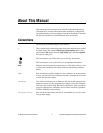
Chapter 1 Introduction
© National Instruments Corporation 1-5 Automotive Diagnostic Command Set User Manual
UDS (Unified Diagnostic Services)
The UDS protocol has become a de facto standard in automotive diagnostic
applications. It is standardized as ISO 15765-3. UDS describes the
implementation of various diagnostic services you can access through the
protocol.
As UDS uses messages of variable byte lengths, a transport protocol is
necessary on layers with only a well defined (short) message length, such
as CAN. The transport protocol splits a long UDS message into pieces that
can be transferred over the network and reassembles those pieces to recover
the original message.
UDS runs on CAN on various transport protocols.
Note The Automotive Diagnostic Command Set supports only the ISO TP (standardized
in ISO 15765-2) and manufacturer-specific VW TP 2.0 transport protocols.
Diagnostic Services
The diagnostic services available in UDS are grouped in functional units
and identified by a one-byte code (ServiceId). Not all codes are defined in
the standard; for some codes, the standard refers to other standards, and
some are reserved for manufacturer-specific extensions. The Automotive
Diagnostic Command Set supports the following services:
• Diagnostic Management
• Data Transmission
• Stored Data Transmission (Diagnostic Trouble Codes)
• Input/Output Control
• Remote Activation of Routine
Diagnostic Service Format
Diagnostic services have a common message format. Each service defines
a Request Message, a Positive Response Message, and a Negative
Response Message. The general format of the diagnostic services complies
with the KWP2000 definition; most of the Service Ids also comply with
KWP2000. The Request Message has the ServiceId as first byte, plus
additional service-defined parameters. The Positive Response Message has
an echo of the ServiceId with bit 6 set as first byte, plus the service-defined
response parameters.


















